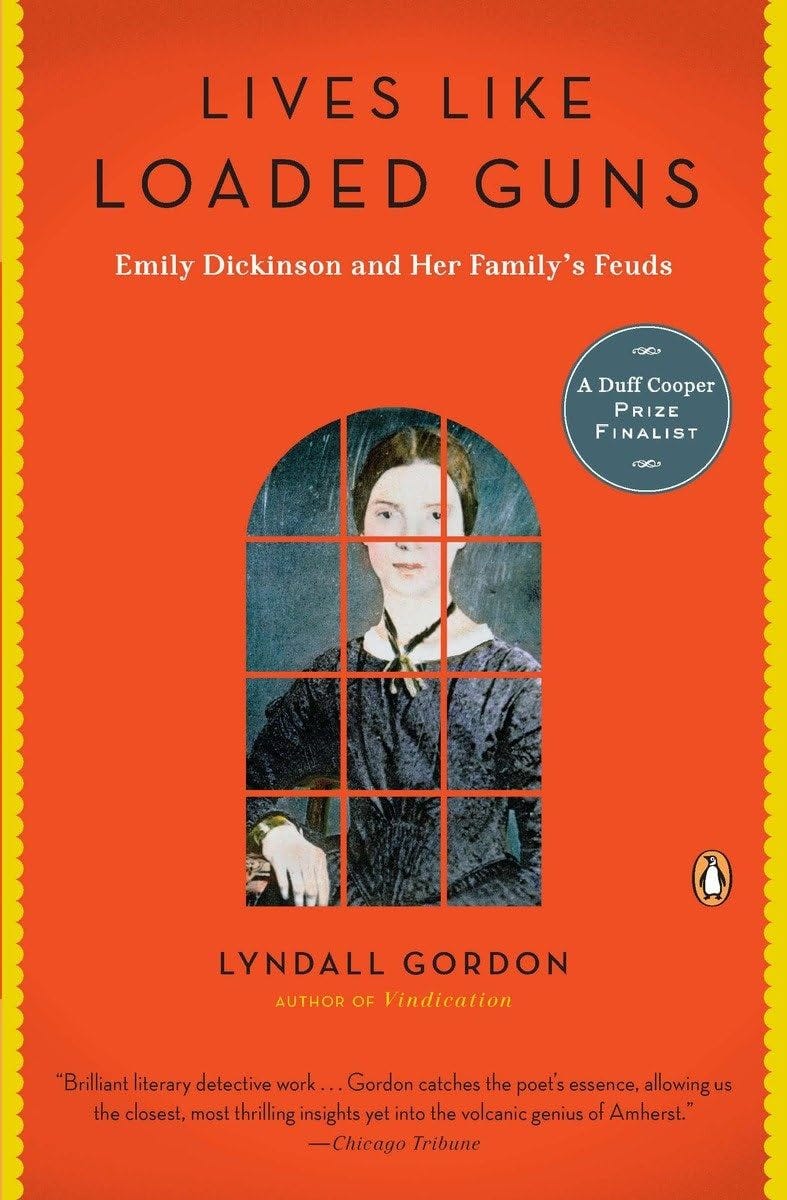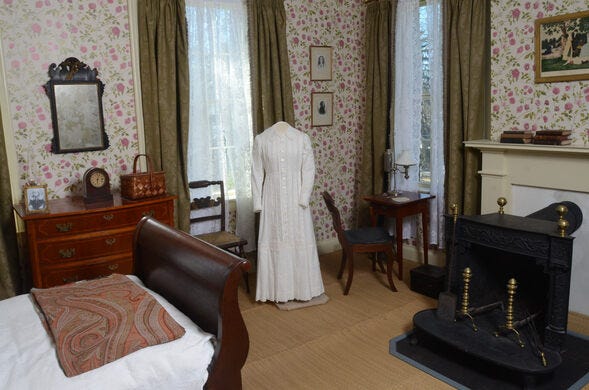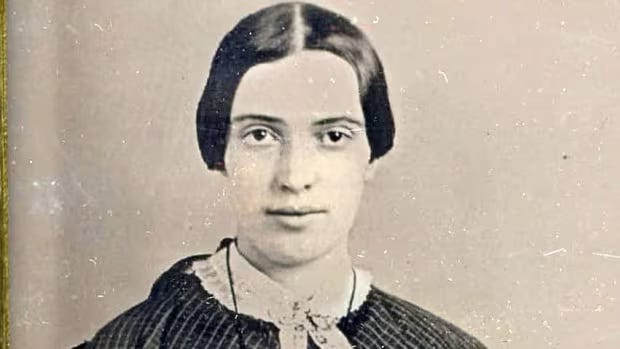Emily Dickinson’s Writing Routine
Dickinson sealed herself away. In silence, she worked her struggles into the abrupt, piercing poems we enjoy.
I have been paging through the book Lives Like Loaded Guns by Lyndall Gordon. It is a captivating biography of Emily Dickinson, but I have some mixed feelings about it.
What I’ve read so far, six chapters in, has been surprising. For some reason I had the idea that a poet would be sweet and gentle. This book seems to focus heavily on her negative traits, making her come across almost as a cruel manipulator. I should have expected something like this, given the title; it’s certainly not a sweet and gentle title.
All the same, I’ve decided not to label her definitively; each biographer is going to focus on what they think is of more interest, and it’s possible that this is simply a new book with a stronger emphasis on the negative, because these traits are not as well-known.
Until I’ve read the second Dickinson biography, I’ll allow her to remain a mystery—a rose with some thorns, like roses tend to have—though I won’t discard the claims, because most are backed with evidence in letters and in poetry.
Emily Dickinson did not have an easy life. She was burdened with secrets that we still struggle to pick apart today.
While those secrets do not excuse cruel behavior, if these claims are true, we must peel back the ‘introverted artist’ label. We must acknowledge that she, like all other authors, was a person with flaws. None of the authors I’ve written about so far were perfect in their behavior, because humans are not perfect.
I will quote from the book Lives Like Loaded Guns quite a bit in this article; click here if you’d like to buy it!
The Introvert, The Poet
Even as we peel back the ‘introverted artist’ cliche, we can’t deny that Emily Dickinson was reclusive. Not all artists and writers are introverts, and certainly not to that degree. However, I have known far more who preferred their own space, especially when it came to their work.
Sometimes it is a matter of focus. I, for one, need silence if I want to write anything worth reading. (I used to be able to work with music on. Don’t ask me why, but that seems to have changed as I grew older).
Neighbors’ claim that she hadn’t left the house in fifteen years might have been exaggerated. (She was a gardener; you have to leave the house to tend a garden!) While I don’t believe that Emily stayed in the house for fifteen years, she did reserve her creative energy for people she knew would appreciate her presence.
She was tentative to make new acquaintances, having experienced the pain of trusting ‘friends’ too much, only to be burned. I can’t claim to be similar to Dickinson in all of the ways I’ve been reading. All the same, I understand what it’s like to trust people, only for all of them to slip away.
Emily Dickinson did not like wearing masks. When she had a friend, she showed her enthusiasm dramatically, and many did not like that. Rather than hold back, she later preferred to remain home alone.
In solitude, she didn’t need to put on airs.
Three-o’-Clock Writer
Lives Like Loaded Guns describes Dickinson’s creative process:
At some point it became her habit to start writing at three in the morning. The invisibility of the night set her free. ‘My Wheel is in the dark’, she begins one poem. She can’t see the spokes of the wheel, but knows its ‘dripping feet’ (the feet of the rhythmic line) go round and round, with the poet’s foot ‘on the tide’ — the tide of words and metaphors: the dark, the wheel, and the ‘unfrequented road’ to an imagined ‘Clearing’. Is ‘Clearing’ the clarification at the end of her poems?
This excerpt made me smile, because I am also a late-night writer.
There’s something about the stillness in the aftermath of a day, the anticipation of sleep, that makes it easier to create. I’ve felt most creative at midnight. I’ve also written quite a bit at three in the morning, sometimes five in the morning. I’ve seen the sun rise while finishing a chapter.
The poem quoted above made me curious, so I looked up the poem in question, which can be found here. These verses struck me:
Some have resigned the Loom— Some in the busy tomb Find quaint employ—
If the Loom in question is her writing, her poetry, then what is the ‘busy tomb’? What does Emily consider to be ‘quaint employ’?
Does she consider a life without creativity to be ‘a tomb,’ or is she referring to the human habit of wearing masks to win approval as ‘quaint employ’ while in the tomb that she is so desperate to avoid?
Because Emily Dickinson did take great measures to avoid the outside world, and the why is speculated, but there seem to be two reasons.
The Path to Being a Hermit
In my previous post, I posed some questions that I’m determined to answer by the end of the month. The foremost of them was why Emily Dickinson decided to embrace the life of a hermit.
With each chapter I read in this biography, it seems that the reason is simple yet complex. Emily Dickinson was different. People who do not fit in, even after making a sincere effort, are seldom accepted. Eventually, they embrace the only option they perceive: solitude.
By the time Emily reached adulthood, she had developed trust issues. She’d experienced piercing disappointment when her friends abandoned her. This book describes her as fiercely loyal, meaning that their abandonment hurt all the more.
Emily’s attachment was so strong that it seemed to frighten off the girls. Was she romantically attached to some of them? Lives Like Loaded Guns is not the only source that suggests her attachments to some friends were more intense than friendship. This conclusion is drawn by scholars who’ve read her letters and poetry, seeking nuggets of truth between dashes and couplets.
Perhaps she was, though it’s unlikely that she would have been overt about that. This was a time when such attachment was still taboo. It might or might not have been the case.
All we know for sure is that Emily Dickinson struggled with relationships. So great was the struggle that she decided not to create new ones.
The Condition of Truth
Illness was another likely reason for her isolation.
Emily reportedly went with her father to visit a specific doctor specializing in epilepsy. This condition was so misunderstood that the Dickinsons chose doctors who were out-of-the-way, in other cities. It appears that they made this choice so that nosy neighbors couldn’t make up stories.
If Emily Dickinson had epilepsy, it adds new context to her poetry. It also appears that some members of her family—a cousin and a nephew—had similar struggles (though they, like her, never used the word epilepsy in letters).
One thing does not change, as the years drag by: people talk. She might have had epilepsy, or maybe her mysterious illness was something else. Regardless, she’d been wounded so much by talk that I understand why she chose silence.
If it’s true that Emily Dickinson struggled with these things, she had two marks that would have made her an outsider at the time. It seems she steered in its direction: instead of being made an outsider by others, she embraced the title, making that lifestyle hers.
Emily took the advice of some of history’s greatest poets:
Other all-time poets have counselled invisibility as the condition of truth. ‘Flee from the prees [crowd],’ Chaucer advised, ‘and dwelle with sothfastnesse.’ ‘I am a crowd, I am a lonely man, I am nothing,’ Yeats declared. None pursued invisibility as strictly as Dickinson. The soul selects its own society, then shuts the door. ‘Noteless’ behind that door, she’s immured against celebrity: ‘I could not bear to live — aloud — / The Racket shamed me so —’. In this way she would pass nine undisturbed hours, broken only by her sunrise task of waking the household with ‘that shrill morning call’ sleepers were ‘sure to hear’.
Grief for Emily Dickinson
I do grieve for people who lived long ago. My brain says this is normal; someone has to, otherwise they would really be dead.
Recently, I dragged through a book about the Salem witch trials called Six Women of Salem. It took me months to finish the book because I could not help wallowing in thoughts of how unfair it was, how lost the accused must have felt, and how dumb the entire situation was. I have yet to write a review about that book, because I’m afraid to revisit those emotions.
I lost sleep over the sufferings of the accused. Today, I feel similarly about Emily, but in a way, she is more difficult to understand. The accused in Salem endured something horrible, but at least I have a clearer idea of why and how, even if the answer is dumb.
When reading about Emily, I feel more confusion with each hint.
This seems intentional. She built a wall around herself. She delighted in the stillness of her home. Late into the night, she sat at her desk and wrote, using dashes to try and cross out emotional wounds.
Emily Dickinson was a sensitive soul, one that outsiders couldn’t understand or place into a compartment. As a girl, she seems to have wished for a circle of people who accepted her. Whenever she chose to trust someone, they disappeared. This happened again and again, until Dickinson sealed herself away.
In silence, she worked her struggle into the abrupt, piercing poems we enjoy. A part of me wishes she didn’t need to be so alone. What would have happened if Emily was born into a different time and place?
If she’d managed to build the community she longed for, perhaps she would not have taken a pen the way she did. Her poems would not have been the same—if she wound up writing at all.
Had this been the case, we might not have had the poetry. However, this soul wouldn’t have been so lonely. Artists often work while pressing bandages to wounds; we take the pen and, sometimes, blood spills out in place of ink.
For the Sake of Art
Another truth can be found in all of this: art has always been necessary for the sake of mental and physical health. We do not always write, draw, create with the goal of publication.
Not all poems are meant to be shared; not all paintings are destined for a gallery.
Emily Dickinson published ten poems in her lifetime, though she wrote nearly two thousand. Why did she leave so many in her drawer, forgotten by her, to be published later and admired by generations?
Lives Like Loaded Guns hints that a doctor who attempted to treat her epilepsy was unable to. Instead of admitting that he failed, he told her to slow down with writing—to slow down with thinking. It is likely, that the doctor’s grim pronouncement pressured her to hide herself.
The thought of it makes me mad. I will write more next Friday about Emily’s struggle with illness, this probable epilepsy. She did not stop writing, but it appears that she lost the desire to publish.
I hope February has treated you well! As usual, feel free to comment with your discoveries or critique.
Emily Dickinson is turning out to be more of a challenge to know than I expected. This is not a problem; it’s a good thing, because what fun would it be if we knew everything?
The Startling Eye of Emily Dickinson
February is about to begin. On this, the last Friday of January, we welcome our next guest to the Tearoom!









Wow, so interesting! :D
This is so intriguing!
I love what you said here: "Artists often work while pressing bandages to wounds; we take the pen and, sometimes, blood spills out in place of ink." It's so true! Often our best work comes out of the worst place that we're in.
Thanks for sharing.